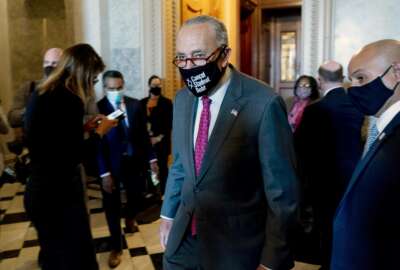In the House, it could shape up to be a big week for infrastructure spending
Congress has fewer than six weeks left to figure out how to avert a government shutdown. But for the moment, the focus is on multiyear spending – including the...
Best listening experience is on Chrome, Firefox or Safari. Subscribe to Federal Drive’s daily audio interviews on Apple Podcasts or PodcastOne.
Congress has fewer than six weeks left to figure out how to avert a government shutdown. But for the moment, the focus is on multiyear spending – including the infrastructure package that got bipartisan support in the Senate, and a separate $3.5 trillion package supported by Democrats. To talk more about what’s ahead on the Hill this week, Federal Drive with Tom Temin was joined by Loren Duggan, deputy news director at Bloomberg Government.
Interview transcript:
Jared Serbu: Loren, thanks for being here. And let’s start with the House Rules Committee, which is going to have a big day, possibly a big week, talk us through some of the measures that they’re going to be considering.
Loren Duggan: Sure, well, this is already a little bit unusual to be talking about the House in August when they’re normally back in their districts to were on vacation for the normal August recess. But they’re coming back this week to tackle some pretty big pieces of legislation. Three are going to come before the rules committee today. The first is a budget resolution that the Senate sent over in their last week of business, which doesn’t matter in itself as much as setting the stage for a later reconciliation package. The second item is the infrastructure deal that the Senate passed also that same week, and sent over to the House, they’re at least going to take it through the rules committee and start the procedural work on that. And then the third is a voting rights act measure that would amend some of the Voting Rights Act law that was passed many years ago and then amended a few times, but really affected by a couple of supreme court cases that Democrats want to rewrite the way that it works in ways that they think would expand voting rights, but will run into some pressure. So those three pieces of legislation, pretty big deals, those will at least start making their way through the rules committee today.
Jared Serbu: As far as the $3.5 trillion package goes, how much does the rules committee process set the final parameters around what that’s going to be? Does that give some finality to what the House version is going to look like or is it still subject to quite a bit of further amendments?
Loren Duggan: It might just send it straight to the floor and get an up or down vote. This resolution itself doesn’t matter as much as what they’re going to be doing in the weeks to come. This is really kicking off the process to write that $3.5 trillion bill. There’s a lot of numbers in this resolution and some policy assumptions, underlining, and I should say that they’re going to eventually write bills with this amount of tax and spending changes in it that will, you know, have a wide reach in the federal government. But this is kind of a procedural step to get there. The Senate passed, adopted it on a party line vote, we’ll likely see that again in the House. Although what’s key in the houses? I know, we talked a lot about the 50-50 majority in the Senate, we’re talking about a 220 to 212 majority in the House, very narrow, they’ve got to really keep the democrats in line, which is one of the reasons that the infrastructure bill is also coming into debate this week, whereas that wasn’t originally in democratic leaders plans.
Jared Serbu: And you mentioned the $3.5 trillion package may go straight to the floor, we’re not even sure at this point that the infrastructure package is going to get to the floor at all until and unless the Senate passes the bigger spending package. Is that still true?
Loren Duggan: Right. Well that’s kind of the delicate dance is going on here, a group of moderates, nine of them have been pressuring Nancy Pelosi to schedule a vote on that infrastructure bill, because they are part of the problem solvers caucus, they’re in the middle of their party, they’d like a win on this infrastructure deal. But there are progressives who don’t want to let the bipartisan package that would increase spending by about 550 billion over the next few years, they don’t want to let that through until this larger package that has more of the social spending that they’d like to see become law moves. So there’s, there’s a lot of maneuvering here by the progressive wing, the moderate wing, the adoption of this budget resolution is a first step. But again, not the details, not the actual tax law changes and spending law changes that will need to be made. So the argument that some have made is let’s, let’s clear the decks of this resolution. We’ll be coming back in the coming weeks to do the reconciliation bill itself, and try to work that out. So I think that’s one of the things that when members get back into town face each other meet as a caucus, they’ll be weighing what to do with that.
Jared Serbu: Yeah, and I think one of the many reasons it’s important to get that that reconciliation package figured out sooner than later is it’s going to determine how much revenue the Democrats are going to need to want to add in their upcoming tax package also, right?
Loren Duggan: Right. And there will be a tax package here. So some of the provisions that will be in this bill will be expanding tax basically payments through the tax system. And one of the ways we’ve seen that already, is to the increase child tax credit, there’s a plan to put an expansion of that in there an extension give that to people for a longer period of time. So that would be a way in which we would increase the deficit through tax changes, but they’ll also be looking for ways to offset or pay for this package, at least in part, to try to bring that 3.5 million number down to a smaller number. Um, there are a number of Democrats, and again, it only takes a few Democrats to really have muscle in this discussion, who are uncomfortable with the size of this package. In the Senate, we saw Joe Manchin and Kyrsten Sinema, from West Virginia and Arizona respectively, both say the number made them a little uncomfortable, and that may push it down. They may also work to get more and more offsets in there to try and limit the total addition to the deficit, even if a higher number could be allowed under this resolution. So like I say, the resolution is kind of setting the parameters for this little layer debate, but that later debate has a lot of steps yet to go.
Jared Serbu: All right. And I guess the other main thing, perhaps not surprisingly, to our listeners happening on the Hill this week is a whole lot of briefings on Afghanistan, I think, right?
Loren Duggan: Yeah, I think we might not see a lot in the open on this, we might see a lot of closed door briefings with members of the administration talking to folks on Capitol Hill, but this will be the first chance that people will be face to face in Washington again. And anytime that happens after a major foreign policy development, there are going to be a number of questions. We’ve heard voices on both sides of the aisle who are not happy with the way that our exit from Afghanistan has gone and, and how they’ve handled some of the evacuations of both US citizens who are there. And then our our allies in Afghanistan who helped us as translators or worked with journalists worked with companies over there are so there are gonna be a lot of questions about what went into the actual exits and what went into the planning and was the intelligence, what we needed to be, was it flawed? I think the Intelligence Committee will do a lot of work behind closed doors on that. So we may not see a lot, but there will be a lot happening behind the scenes on Afghanistan to be sure.
Jared Serbu: All right. Loren Duggan is deputy news director at Bloomberg Government. Loren, thanks as always.
Loren Duggan: Thank you.
Copyright © 2024 Federal News Network. All rights reserved. This website is not intended for users located within the European Economic Area.
Tom Temin is host of the Federal Drive and has been providing insight on federal technology and management issues for more than 30 years.
Follow @tteminWFED






